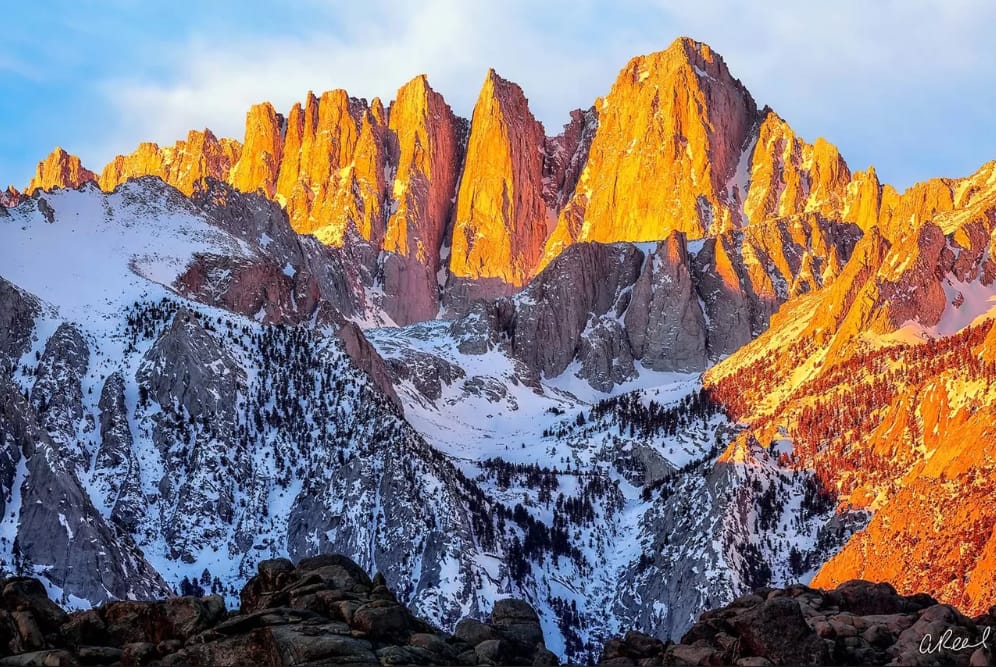These diverse figures have shaped what it means to capture a landscape, from sublime sweeping mountain scenes to intimate representations of human intervention. These photographers taught us how landscape photography can communicate stories and feelings beyond our everyday experience of nature.
Ansel Adams
Ansel Adams is widely regarded as one of the greatest landscape photographers of all time. His black–and–white photographs of the American West, particularly Yosemite National Park, are instantly recognisable and have gone a long way in shaping how we see and talk about landscape photography today. His ability to create compositions that simultaneously focused on abstract details while still capturing the wide branching majesty of sweeping landscapes taught us how to re-see our environments through new eyes.

Gregory Crewdson
Gregory Crewdson’s photographs have become an American visual lexicon evocatively communicating the American experience with no words. While his images disguise themselves as passing everyday moments, Crewdson’s images are highly choreographed. Often working with a large team, Crewdson typically plans each image with meticulous attention to detail, orchestrating light, colour, and production design to conjure dreamlike scenes infused with mystery and suspense.

Galen Rowell
Galen Rowell influenced a whole generation of landscape photographers. Rowell made adventure synonymous with the idea of a landscape photographer. Not only was Rowell a photographer, but he was also a professional mountaineer, which aided him in his relentless pursuit of capturing the unseen beauty of the untouched wilderness. His images are known for their vivid colours and dramatic compositions. Rowell not only created iconic imagery but also created the archetype of the wilderness photographer.

Jeff Wall
Jeff Wall is renowned for his large-format photographs with subject matter that ranges from mundane corners of the urban environment, to elaborate tableaux that take on the scale and complexity of 19th-century history paintings. Unlike the other photographers on this list, Jeff Wall doesn’t seek to capture untouched landscapes, he creates highly manipulated choreographed scenes that tell a story.

Edward Weston
Edward Weston was a pioneering photographer who is best known for his modernist black-and-white images of landscapes, still lifes, and nudes. Weston brought landscape photography into the fine art world, using dramatic manipulations and intense use of light and shadow to create evocative dialogues between natural forms and human presence. Weston expanded thinking about landscapes as a fine art subject.

Stephen Shore
Stephen Shore’s approach to photography is both deadpan and contemplative. Shore emerged in the 1970s as one of the major exponents of colour photography, shooting bleak yet lyrical scenes of the North American landscape. Documenting everyday settings and objects, from hotel swimming pools and televisions to parking lots, gas stations, and deserted roads, Shore exhibited an ability to subvert commonplace surroundings through his lens, forcing us to take another look at capitalist America.

Rick Dingus
Rick Dingus continuously refashioned 20th and early 21st century understanding of landscape and place. Dingus was interested in the paradoxes of time and place, the uncertain documentary authority of a photograph, and the flexible meanings of any image. Dingus challenged the notion that you must capture the landscape as it is, using creative medium subversions to expand the meanings of his photographs, like his tendency to re-photograph existing landscape photographs, drawing borders around his prints, or scribbling out qualities he wanted to conceal.

Richard Misrach
Richard Misrach is a highly influential photographer who has made a significant impact on his generation. His well-known series, Desert Cantos, is a multifaceted exploration of place and the intricate relationship between man and his environment. Misrach has been working in the landscape photography field for over four decades, and in the 1970s, he was one of the pioneers of colour photography and large-scale presentation techniques that are still widely used today.

Murray Fredericks
Australian photographer Murray Fredericks through his landscape photography creates spiritually minded encounters with the hyper-real. Often creating points of focus within his images through his own manipulation (e.g. lighting a fire or placing a mirror), Murray’s images ask us to consider infinity, while also making us hyper-aware of our own finite scale. Fredericks’s work is derived from a perspective that views culture as something that cannot be wholly accounted for through social construct. It’s a view that sees some values as derived from a ‘time-less essence’. The work attempts to represent the experience when thought is temporarily suspended and the mind encounters ‘other’.

Edward Burtynsky
Edward Burtynsky explores landscapes that have been transformed by human enterprise, what he calls the “indelible human signature” on the planet. Burtynsky’s large-scale aerial photographs reference the often surreal qualities of human-altered landscapes. Chronicling the major themes of terraforming and extraction, urbanisation and deforestation, Burtynsky conveys the unsettling reality of sweeping resource depletion and extinction.

Andreas Gursky
Andreas Gursky is a famous German photographer known for his stunning, digitally enhanced photos of cities, landscapes, and interiors. His work explores the connection between humans and nature and often includes social commentary. “Rhine II” (1999) is one of his most famous images, showcasing a peaceful section of the Rhine River in Germany. The photo’s serene composition was created through digital manipulation, removing all people and objects in the scene.

Feeling inspired? Keep an eye out for the opening for the Head On Landscape Awards!














0 Comments